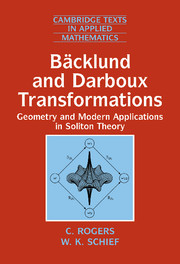Book contents
- Frontmatter
- Contents
- Preface
- Acknowledgements
- General Introduction and Outline
- 1 Pseudospherical Surfaces and the Classical Bäcklund Transformation. The Bianchi System
- 2 The Motion of Curves and Surfaces. Soliton Connections
- 3 Tzitzeica Surfaces. Conjugate Nets and the Toda Lattice Scheme
- 4 Hasimoto Surfaces and the Nonlinear Schrödinger Equation. Geometry and Associated Soliton Equations
- 5 Isothermic Surfaces. The Calapso and Zoomeron Equations
- 6 General Aspects of Soliton Surfaces. Role of Gauge and Reciprocal Transformations
- 7 Bäcklund Transformation and Darboux Matrix Connections
- 8 Bianchi and Ernst Systems. Bäcklund Transformations and Permutability Theorems
- 9 Projective-Minimal and Isothermal-Asymptotic Surfaces
- Appendix A The su(2)–so(3) Isomorphism
- Appendix B CC-Ideals
- Appendix C Biographies
- Bibliography and Author Index
- Subject Index
General Introduction and Outline
Published online by Cambridge University Press: 04 March 2010
- Frontmatter
- Contents
- Preface
- Acknowledgements
- General Introduction and Outline
- 1 Pseudospherical Surfaces and the Classical Bäcklund Transformation. The Bianchi System
- 2 The Motion of Curves and Surfaces. Soliton Connections
- 3 Tzitzeica Surfaces. Conjugate Nets and the Toda Lattice Scheme
- 4 Hasimoto Surfaces and the Nonlinear Schrödinger Equation. Geometry and Associated Soliton Equations
- 5 Isothermic Surfaces. The Calapso and Zoomeron Equations
- 6 General Aspects of Soliton Surfaces. Role of Gauge and Reciprocal Transformations
- 7 Bäcklund Transformation and Darboux Matrix Connections
- 8 Bianchi and Ernst Systems. Bäcklund Transformations and Permutability Theorems
- 9 Projective-Minimal and Isothermal-Asymptotic Surfaces
- Appendix A The su(2)–so(3) Isomorphism
- Appendix B CC-Ideals
- Appendix C Biographies
- Bibliography and Author Index
- Subject Index
Summary
The foundations of the differential geometry of curves and surfaces were laid in the early part of the nineteenth century with the monumental works of Monge (1746–1818) and Gauss (1777–1855). Monge's major contributions were collected in his Applications de l'Analyse ‘a la Gèometrie published in 1807. The 1850 edition of that work is of particular value in that it includes an annotation by Liouville (1809–1882) detailing additional contributions to the subject by such luminaries as Frenet (1816–1888), Serret (1819–1885), Bertrand (1822–1900) and Saint-Venant (1796–1886), whose work in geometry was motivated by his interest in elasticity. Gauss’ treatise on the geometry of surfaces, in-stigated by a geodetic study sponsored by the Elector of Hanover, was the Disquisitiones Generales Circa Superficies Curvas published in 1828. Therein, Gauss set down the system of equations that bears his name and which time has shown to be fundamental to the analysis of surfaces. Indeed, this Gauss system and the symmetries that it admits for privileged classes of surfaces underpin the remarkable connection between classical differential geometry and modern soliton theory to be the subject of this monograph.
The origins of soliton theory are likewise to be found in the early part of the nineteenth century. Thus, it was in 1834 that the Scottish engineer John Scott Russell recorded the first sighting, along a canal near Edinburgh, of the solitary hump-shaped wave to be rediscovered in 1965 in the context of the celebrated Fermi-Pasta-Ulam problem by Kruskal and Zabusky and termed a soliton.
- Type
- Chapter
- Information
- Bäcklund and Darboux TransformationsGeometry and Modern Applications in Soliton Theory, pp. 1 - 16Publisher: Cambridge University PressPrint publication year: 2002



